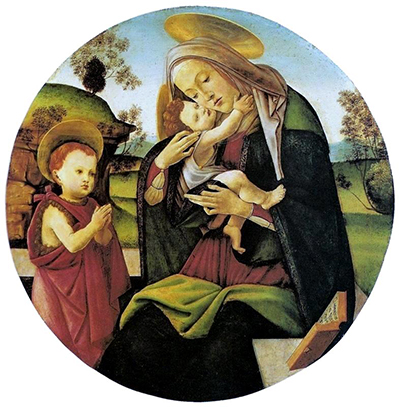This tondo was titled Virgin and Child with the Infant St. John the Baptist and is one of many works by Sandro Botticelli which focused on the theme of the Madonna and Child. This particular piece now resides in the São Paulo Museum of Art, Brazil and is dated at around the 1490s.
This touching portrait is displayed today within a specially-made rounded frame with the overall piece believed to be 74cm in width and height. It is highly rare to find any of this artist's paintings within South America, with most remaining in Europe, and a few having made it to some of the major art galleries of the US. The artist made use of a round wooden panel on which he created form using egg tempera, which was the chosen method for members of the Italian Early Renaissance. For this particular piece the artist may also have called upon the services of two of his most trusted assistants, namely Bartolomeo di Giovanni and Raffaelino di'Carli, although it is unlikely that this could ever be known for sure. Experts have dated this piece in accordance with the compositional style, with this approach being found more commonly in the latter stages of this artist's career.
There seemed no end to Botticelli's devotion to the Madonna and Child image. He would return to it again and again as his career progressed, and even when he enjoyed a certain level of autonomy in how he was working, he would still continue to revisit the topic with new ideas and innovations for the full span of his lifetime. The artist was sensitive to this beautiful connection and loved to find new ways of re-creating the bond in his work. It may well have been that others saw these paintings and requested the same theme for their own commissions, as his reputation spread far and wide, reaching well outside the boundaries of his native Florence. Today many of these different interpretations have made their way into small private collections, with some being discovered and attributed to the artist relatively recently.
Another artist to have impressed with religious content in his paintings was Murillo, a Spanish Baroque painter. He would also bring about the use of genre painting which had not been seen much in Spain up to that point. Examples of this included the likes of A Peasant Boy Leaning on a Sill, Four Figures on a Step and Two Children Eating a Melon and Grapes, with many of these artworks being sold abroad where this style proved most popular. Murillo tended to offer his domestic audience religious content instead, as their tastes were relatively more traditional at that time. He would make use of strong trade links within Seville which enabled him to connect to different markets in other countries and he would eventually become more famous abroad than he was in his own native Spain which was a fairly unusual scenario, but not completely unknown.




